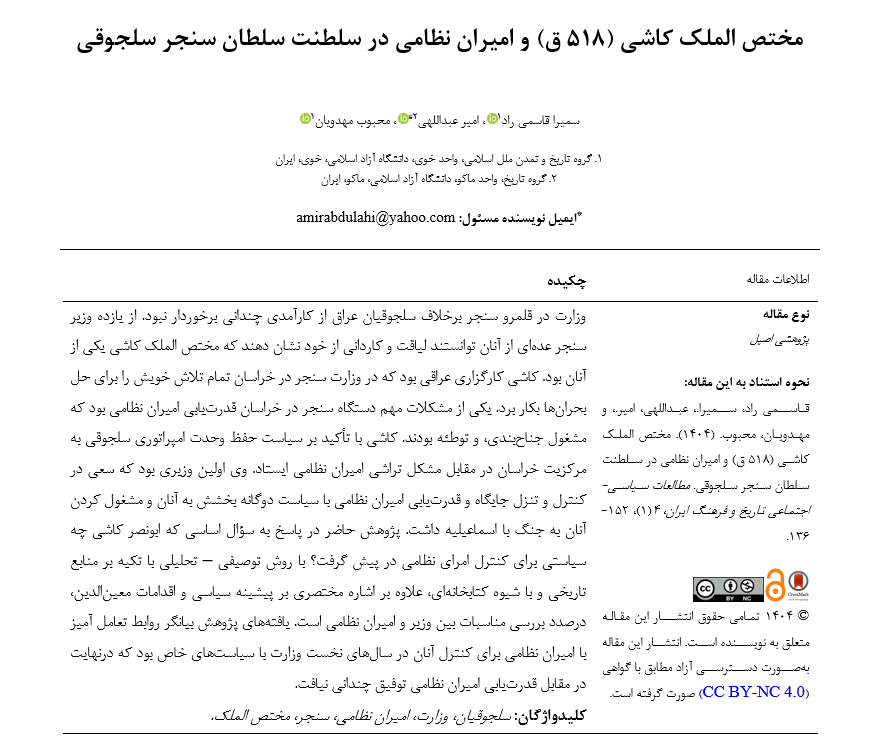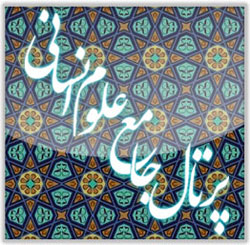Al-Mulk Minister and military commands in the reign of Sanjar
Keywords:
Seljuks, Ministry, Military Emirs, Sanjar, Mukhtar al-MulkAbstract
The ministry wasn’t very efficient in the territory of Sanjar, unlike the Iraqi Seljuks. Some of them were able to show their worthiness and expertise, and one of them is Al-Mulk Kashi. Sanjar's eleven ministers a small number of them were able to show their merits and expertise and one of them belonged to Al-Mulk Kashi. Mukhtar al-Mulk was an Iraqi broker who made every effort to resolve the current crisis at the Sanjar Ministry in Khorasan. Mukhtar al-Mulk, by emphasizing the policy of preserving the unity of the Seljuk Empire stood against the problem of military kings. Although the minister's efforts were thwarted by his assassination by the Ismailis. A fundamental question is what policy did Abu Nasr Kashi pursue to control military commanders? with a descriptive analytical method based on historical sources and with a library method in addition to a brief reference to the events of the time and political background and actions of Moinuddin Seeks to examine the relationship between the minister and the military kings. The finding of the study showed interactive relations with the military to control them by implementing specific policies that ultimately didn’t succeed in the extravagance and empowerment of the military.
Downloads
References
Aghili, S. D. (1985). Akhbar al-Wuzara. Tehran: Information.
Bandari. (1977). Zubdat al-Nasr wa Nukhbat al-Asr. Tehran: Foundation of Culture.
Bayhaqi, I. F. History of Bayhaqi. Tehran: Foroughi Bookstore.
Bosworth, C. E. (2001). The Seljuks. Tehran: Tehran Publishing.
Boyle, J. A. (2001). Cambridge history of Iran. Tehran: Amir Kabir.
Ghazali, I. M. (1954). Fada'il al-Anam min Rasail Hujjat al-Islam. Tehran: Sanaei and Tahouri.
Halimi, A. K. (2004). The Seljuk state. Tehran: Research Institute of Hawzah and University.
Hassan-Zadeh, I. (2006). A different approach to the political behavior of Abu al-Qasim Dargazini. Historical Essays, 19(4).
Hassan-Zadeh, I. (2007). Reforms and political instability during the Seljuk period. Research Journal of the Faculty of Literature and Humanities, Isfahan University, 2(50).
Hassan Zadeh, I., & Abdollahi, M. (2014). Reforms of Kamal al-Din Khazan. Journal of the History and Civilization of Islamic Nations(19).
Hosseini, A. (2025). News of the Seljuk state. Beirut.
Ibn Athir, I. (1972). The complete history of Islam and Iran. Tehran: Scientific Publishing.
Ibn Hawqal. (1987). Surat al-Ard. Tehran: Amir Kabir.
Ibn Khaldun, A. (1985). Al-Ibar. Tehran: Cultural Studies and Research.
Iqbal, A. (2009). The ministry during the reign of the Great Seljuk Sultans. Tehran: University Press.
Katib Isfahani, I. D. (2006). History of the Saljuqid dynasty. Beirut.
Khatibi, A. Abu Nasr Kashi In: Encyclopedia of Islam (Vol. 6). Tehran: Center for the Great Islamic Encyclopedia.
Khwandamir, G. (1956). Dastur al-Wuzara. Tehran: Iqbal.
Klozner, K. (2002). Bureaucracy in the Seljuk era. Tehran: Amir Kabir.
Lampton, A. K. S. (1984). A journey through the history of Iran after Islam. Tehran: Amir Kabir.
Lampton, A. K. S. (1993). Continuity and change in the medieval history of Iran. Tehran: Ney Publishing.
Manzooralajdad, S. M. H. (2004). The political power of the Imamites during the Seljuk dynasty. Journal of Islamic History(18).
Monshi Kermani, N. (1983). Samat al-Ali lil-Hadra al-Ulya. Tehran: Asatir.
Monshi Kermani, N. (1985). Nasaim al-Asrar. Tehran: Information.
Mostowfi, H. (1985). Taarikh-e Gozideh. Tehran: Amir Kabir.
Motahari, H. R. (2015). Imamite Shiite agents in the Seljuk government apparatus. Journal of Historical Speech, 9(21).
Neyshaburi, Z. D. (1953). Seljuknameh. Tehran: Kallaleh Khavar.
Nizam al-Mulk Tusi, Q. D. (1961). Siyasatnama. Tehran: Habibi Book Company.
Qazvini, R. (1979). Ba'da al-Mathalib al-Nawasib fi Naqz Ba'da Fada'il al-Rafidah. Tehran.
Qomi, H. b. A. History of Qom. Tus Publishing.
Qomi, N. D. (1985). History of the ministers. Tehran: Institute for Cultural Studies and Research.
Rashid al-Din Fazlullah, H. (1983). Jami' al-Tawarikh. Tehran: Donyaye Ketab.
Rawandi, M. b. A. (1984). Rahat al-Sudur wa Ayat al-Surur. Tehran: Scientific Publishing.
Sadeghi, M. A. (1998). The position of the ministry during the reign of Sanjar. Journal of the Faculty of Literature and Humanities, Tabriz, 66.
Sanders, K. (2010). Bureaucracy in the Seljuk era. Tehran: Amir Kabir.
Satarzadeh, M. (2013). The Seljuks. Tehran: Samt Publishing.
Tahmasbi, S. (2003). Competition between the Iraqis and Khorasanis in Seljuk bureaucracy. Letter of the Association(3 & 4).
Tatuvi, Q. A. K. Tarikh al-Fai. Tehran: Scientific and Cultural Publishing.
Yaqut al-Hamawi, S. A. (1960). Mu'jam al-Buldan. Beirut: Dar al-Ihya al-Turath al-Arabi.
Youssefi Far, S. (2008). The political, social, economic, and cultural transformations of Iran during the Seljuk period. Tehran: Payame Noor University.








